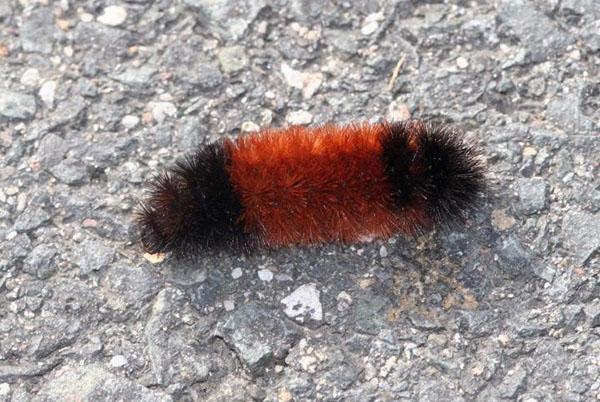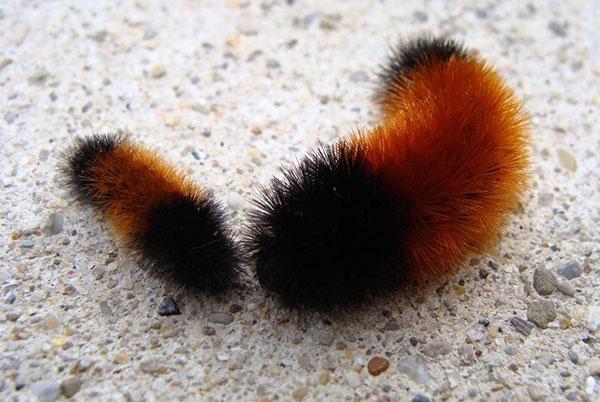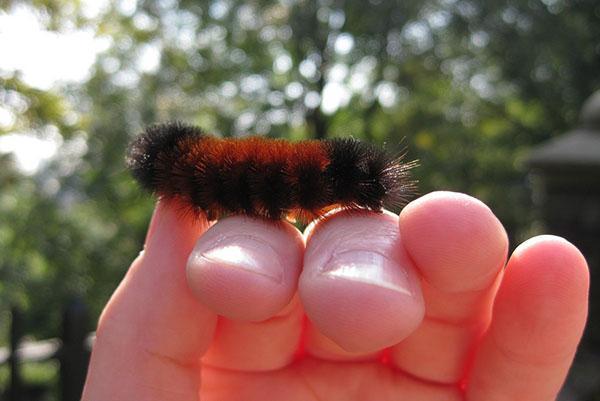How hairy caterpillars can predict the weather
 About a hairy caterpillar - it is also called a woolly or hairy worm, a bear - there is a belief that it is able to predict the arrival of winter frosts. Whether it's a fact or a fictitious omen, we'll tell you about this famous caterpillar and how to “read” its color.
About a hairy caterpillar - it is also called a woolly or hairy worm, a bear - there is a belief that it is able to predict the arrival of winter frosts. Whether it's a fact or a fictitious omen, we'll tell you about this famous caterpillar and how to “read” its color.
Legend has it that the body of a hairy caterpillar consists of 13 separate segments, brown with red or black. The wider the brown areas, the milder the coming winter will be. If blacks prevail, then the winter will be harsh.
How the "bear" got its fame

Curran collected as many caterpillars as he could in a day, determined the average number of brown segments, and predicted when winter weather would come. This experiment was covered in the New York press by his fellow reporter.
 Dr. Curran continued his research for the next 8 years, trying to scientifically substantiate this weather sign, which is as old as the hills around Bear Mountain. As a result of the widespread publicity, the hairy caterpillar has become the most recognizable caterpillar in North America.
Dr. Curran continued his research for the next 8 years, trying to scientifically substantiate this weather sign, which is as old as the hills around Bear Mountain. As a result of the widespread publicity, the hairy caterpillar has become the most recognizable caterpillar in North America.
A bit of theory
 The caterpillar that Dr. Curran examined is the larval form of the Pyrrharctia isabella moth, or Isabella the Bear.
The caterpillar that Dr. Curran examined is the larval form of the Pyrrharctia isabella moth, or Isabella the Bear.
It is a medium-sized insect with yellow-orange wings with black spots. Distributed in the northern part of Mexico, the United States and southern Canada. In the moth stage, it is no different from the others, however, the undeveloped larva called the woolly bear is one of the few caterpillars that humans can identify.
In fact, the caterpillars are not covered with hair, but with short bristles of coarse hair. They hibernate in cavities inside tree trunks and under bark, so in the fall you can often see a whole caravan crossing roads and sidewalks.
In spring, female bears wrap themselves in cocoons and turn into moths inside them. As a rule, the ends of the body of the caterpillar are colored black, and the middle is brown. This is their distinctive color.
Can hairy caterpillars predict winter weather?
 From 1948 to 1956, Curran found that the average number of brown segments ranged from 5.3 to 5.6 of the total of 13. Thus, the brown stripe occupied more than a third of the entire body area. The winters that happened during this period were mild, and Curran concluded that there was logic in the ancient belief, and it may turn out to be true.
From 1948 to 1956, Curran found that the average number of brown segments ranged from 5.3 to 5.6 of the total of 13. Thus, the brown stripe occupied more than a third of the entire body area. The winters that happened during this period were mild, and Curran concluded that there was logic in the ancient belief, and it may turn out to be true.
But the researcher had no illusions on this score. He knew that his experiences were too insignificant. And, although many believed in his theory, it remained only a reason for ridicule among the majority. Curran, with his wife and a group of friends, left town every fall to collect new caterpillars. They founded the so-called "Society of Friends of the Furry Worm".
30 years after the last meeting of the Society, the research has been resumed by the Nature Museum of the Medvezhya Gora National Park. Since then, the attitude towards calculations and forecasts has become more serious than before.
 For the past 10 years, Banner Elk, North Carolina has hosted the annual Autumn Fur Worm Festival. The event culminates in a track race.The former mayor of the city examines the winner and makes a forecast for next winter: the more brown segments, the milder the winter. If black predominates, the winter will be harsh.
For the past 10 years, Banner Elk, North Carolina has hosted the annual Autumn Fur Worm Festival. The event culminates in a track race.The former mayor of the city examines the winner and makes a forecast for next winter: the more brown segments, the milder the winter. If black predominates, the winter will be harsh.
Most scientists underestimate the wool caterpillar superstition, considering it just a prejudice. They believe it is completely futile to look at the hideous mass of caterpillars in the same place for years, trying to prove folk fables.
Entomologist Mike Peters of the University of Massachusetts does not support the general opinion. According to him, there is indeed a connection between the severity of winter and the brown coloring of the bear. There is evidence that the number of brown stripes indicates the age of the caterpillar. Therefore, one can judge about a long winter, or about early spring. Only now this refers to the past period, and not to the coming one next year.
Hairy worms look different every year. It depends on their region of residence. If you suddenly come across a woolen caterpillar, examine its colors and make your own forecast for the coming winter.